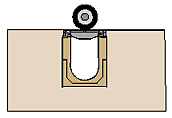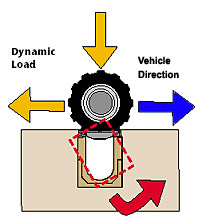Wheel loads
|
Weight of vehicle and its typical load |
|
Type of wheels - solid or pneumatic tyres |
|
Possibility of unusual vehicles, e.g.,
trolleys/skips, traversing the trench |

Larger and/or pneumatic tyres spread the load over a larger contact area - exerting a low stress.

Small and/or solid tyres concentrate the load onto a small contact area, exerting a high stress.
A grate and/or system with a higher load rating will be required in these applications. |
|
Static loads
|
Load/weight applied vertically onto the trench, no other movement. |

Static loads are used in load authorities, but poorly simulate real traffic scenarios. However, they provide an independent measuring scale to compare and classify grates. |
|
Dynamic loads
|
Will vehicles be travelling across or along the trench? |
|
Will traffic be braking or turning on the trench? |
|
Frequency of traffic? |
|
Speed of traffic? |
|
Is trench located at bottom of a ramp? |

Moving traffic creates a dynamic effect. This movement acts to twist the trench drain out of position. Trench body, grate loading, installation, and locking mechanisms, are all important factors to consider when addressing dynamic loads.
The more movement (turning and/or
braking) and the faster the traffic, the
greater the dynamic load. |